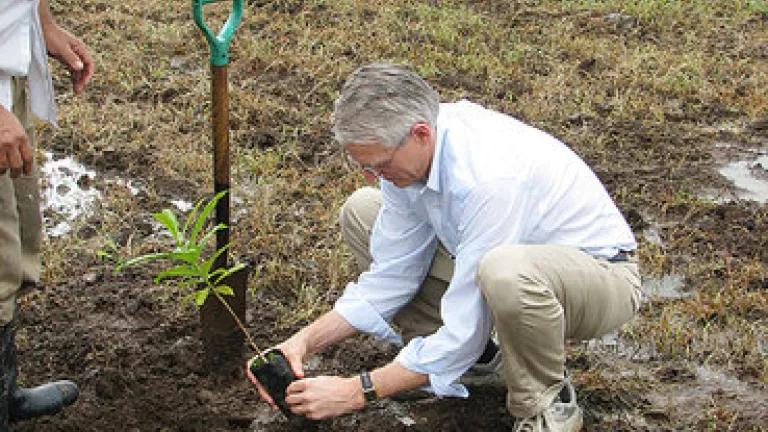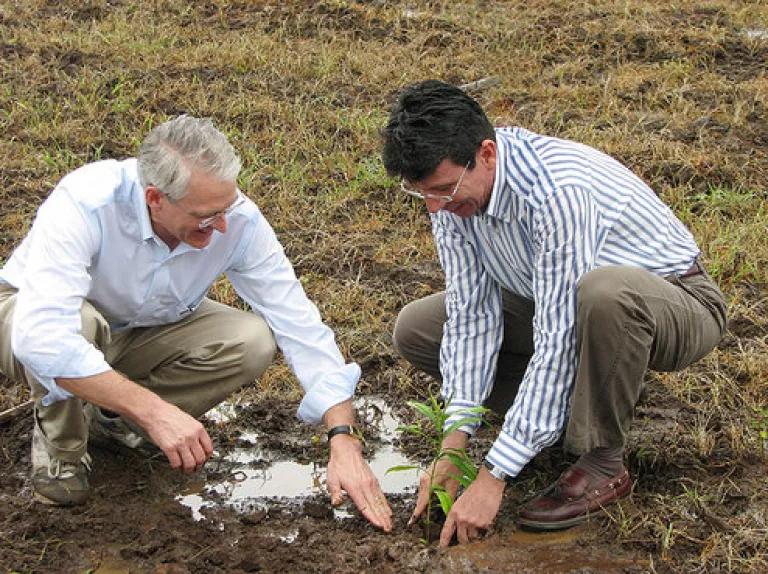
TURRIALBA, Costa Rica -- There is a reason they call them rainforests. It was pouring as I put the first tree into the ground here in a new forest that NRDC is planting with the support of our members. The one good thing about all that rain: it made it easier to dig the hole.
We’re planting the rainforest in Costa Rica in an area that long ago was a rainforest, but for the last 50 or 100 years has been a cattle farm. Nearby are other existing forests as well as some other acreage that we hope will also get replanted as forest. The seedling I planted, a native species called Vochysia, was about 10 inches high. I had just stood by a Vochysia tree that was about 30 feet high and only 5-6 years old. Trees and other plants grow so quickly here that it is very exciting to think that birds will be perching in the tree I planted within a couple of years.
Jose Joaquin Campos, the director of CATIE – the Center for Tropical Agriculture, Investigation, and Education – showed me the area and also planted a tree. Campos works with students from more than 20 countries in Latin America, teaching them all sustainable farming and other practices.

In the area of the new rainforest, they have carefully studied the watershed. The area feeds one of Costa Rica’s largest rivers but it has a lot of small towns with few sewage facilities and farms that cause a great deal of erosion. So they are working hard to restore the area and to teach farmers how to conserve their soil.Many of the trees in NRDC’s forest will be planted by local school children or by local farmers learning about tree planting so they can plant native trees on some of their land.
It’s quite something to drive around this part of Costa Rica. It rains a lot so it’s very lush. But much of the lush greenness is pasture for dairy cows. Some call it the Switzerland of Latin America. But those lush fields are almost all former rainforests so to understand lushness is only possible when you go into the rainforest itself.
In the forest, the vegetation is so think it’s impossible to go anywhere not on a path. I counted about 15 types of ferns in a few minutes (and I’m no expert). Trees of all sizes and shapes. I could hear lots of birds, but see few of them in the foliage. Even the air smells and feels vibrant. Of course, with all this tree cover, the land retains its soil moisture better and there is far less erosion and runoff so the nearby streams are richer as well.

Indeed, not so long ago, I walked up a stream to see a big waterfall nearby the new forest. There was no path and the only way was to go up the stream itself, walking in the water. The rainforest – also a second growth forest that is now legally protected – came right down to water’s edge. Blue morpho butterflies and many others I don’t know the name of flitted by. Small waterfalls brought little rivulets into the stream. It was clear that stream and rainforest were one joint ecosystem.
The NRDC forest-to-be will connect several of Costa Rica’s parks, allowing animals to freely roam amidst the rivers and streams crossing the area like arteries. It’s nice to be able to take a break from law books and memos to see our work literally take root.
